Large Ensemble:
Upstream (2017), for electric violin and jazz band (6:00)
Score (PDF) | Video (YouTube)
Charles Nichols, electric violin
Virginia Tech Jazz Ensemble
Jason Crafton, director
Washington and Jefferson Jazz Ensemble
Kyle Simpson, director
Upstream is a smooth funk chart, featuring heavily processed electric violin, soloing over echoing and harmonizing sax lines, building and stabbing brass chords, and a driving rhythm section, alternating between contrasting grooves. The piece was written for the Washington and Jefferson Jazz Ensemble and director Kyle Simpson.
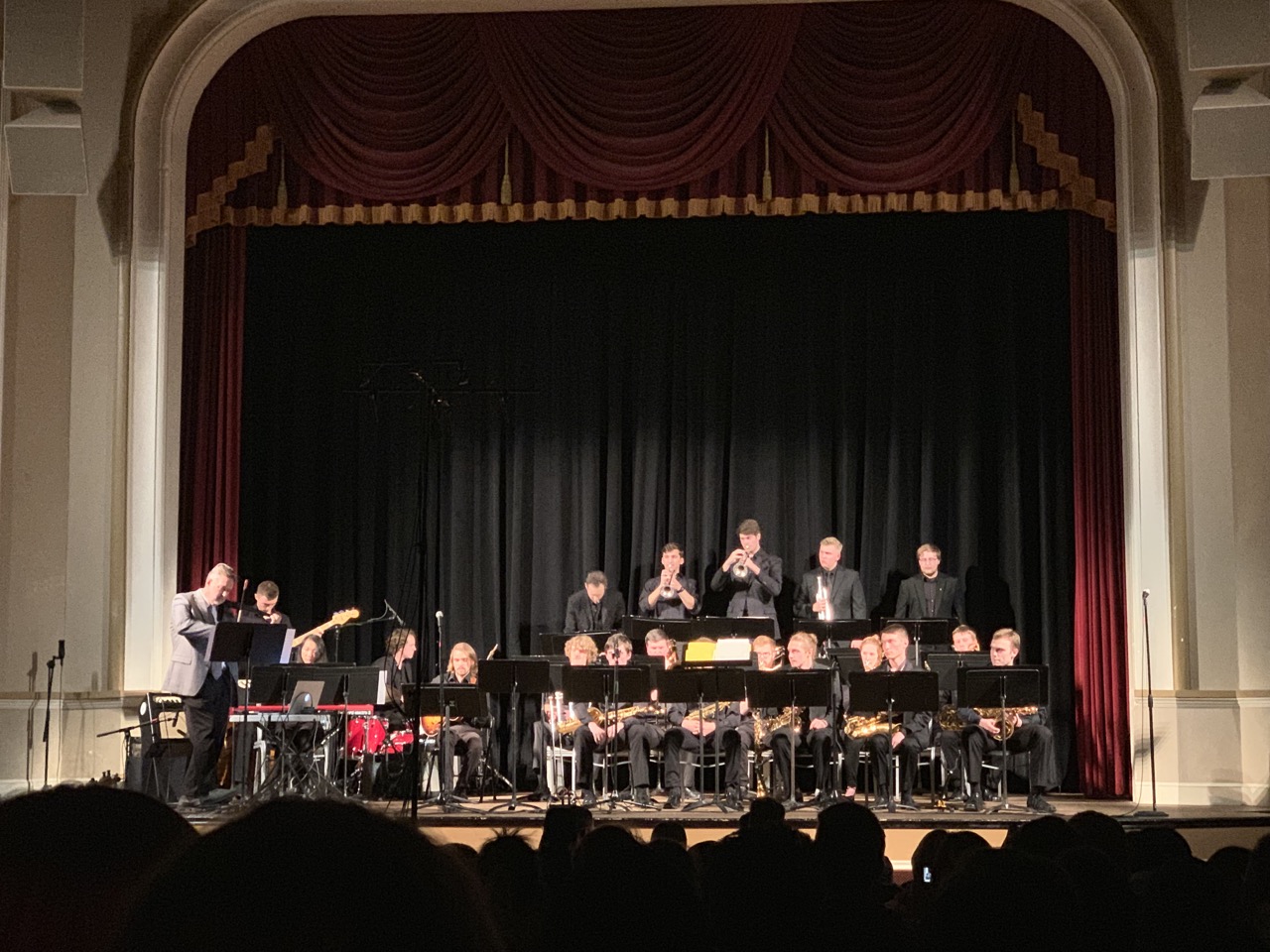
Electric violinist Charles Nichols performed Upstream with the Virginia Tech Jazz Ensemble and Washington and Jefferson Jazz Ensemble at
- Olin Fine Arts Center at Washington and Jefferson College in Washington, PA, December 1, 2017
- Lyric Theatre in Blacksburg, VA, March 1, 2019
Chicken and Grits (2015), for electric cello, marimba, and jazz band (8:10)
Score (PDF) | Audio (MP3) | Video (YouTube)
Alan Weinstein, electric cello
Annie Stevens, marimba
Virginia Tech Jazz Ensemble
Jason Crafton, director
In Chicken and Grits for electric cello, marimba, and jazz band, the electric cello or violin and amplified marimba play variations on a melody, within alternating rock and shuffle grooves. The piece was written for cellist Alan Weinstein, percussionist Annie Stevens, the Virginia Tech Jazz Ensemble, and director Jason Crafton.

Chicken and Grits was performed by
- cellist Alan Weinstein, percussionist Annie Stevens, the Virginia Tech Jazz Ensemble, and director Jason Crafton, in the Cube of the Moss Arts Center at Virginia Tech in Blacksburg, VA, March 4, 2015
- cellist Liz Burns, percussionist Jennifer Hotz, Winthrop University Jazz Ensemble, and director Tracy Patterson, at the College Music Society Mid Atlantic Regional Conference in Barnes Recital Hall at Winthrop University in Rock Hill, SC, February 26, 2016
- electric violinist Charles Nichols, percussionist Mitchell Greco, the Washington & Jefferson Jazz Ensemble, and director Kyle Simpson, in the Olin Fine Arts Center at Washington & Jefferson College in Washington, PA, December 1, 2017
Nicolo, Jimi, and John (2013), for amplified viola, computer, and orchestra
Score (PDF)
- I. Nicolo (inspired by Paganini) (11:49)
Audio (MP3) | Video (YouTube) - II. Jimi (inspired by Hendrix) (11:03)
Audio (MP3) | Video (YouTube) - III. John (inspired by Coltrane) (10:31)
Audio (MP3) | Video (YouTube)
Brett Deubner, viola
Darko Butorac, conductor
Missoula Symphony Orchestra
with Charles Nichols, computer
Nicolo, Jimi, and John, is a three-movement concerto for amplified viola, interactive computer effects, and orchestra, a celebration of virtuosity inspired by the great performers Paganini, Hendrix, and Coltrane. Interactive computer effects are used to expand the expressive potential and timbral palette of the amplified acoustic viola, while colorful orchestration for doubled woodwinds and brass and multiple percussion accompanying the technical solo viola part, expanding Classical instrumentation and translating the instrumental roles of Rock and Jazz bands in sections of the orchestra. The Nicolo movement explores Neo-Classical form, themes, and harmonic motion, using chords and scales built from stacked triads and sevenths. The orchestration is colorful, taking advantage of expanded woodwind, brass, and percussion sections, and the computer extends the rhythm of the solo part, with delays doubling layers of passage work in different octaves. The Jimi movement showcases many of Hendrix' riffs and extended techniques transferred to viola, while the orchestra accompanies with psychedelic, pulsing, and streaming textures, and the computer produces distortion and wah effects to color the timbre of the solo viola. The John movement surveys the melodic gestures, harmonic language, textures, and structures of Coltrane’s recordings in a three-part form, with the orchestra doubling lines, comping chords, and driving the rhythm section, and the computer extending the pitch of the solo part with harmonization. Nicolo, Jimi, and John was commissioned by the Missoula Symphony Orchestra with support from the PROP Foundation, composed during residencies sponsored by the Ucross and Brush Creek Foundations, and prepared with a grant from the New Music USA.
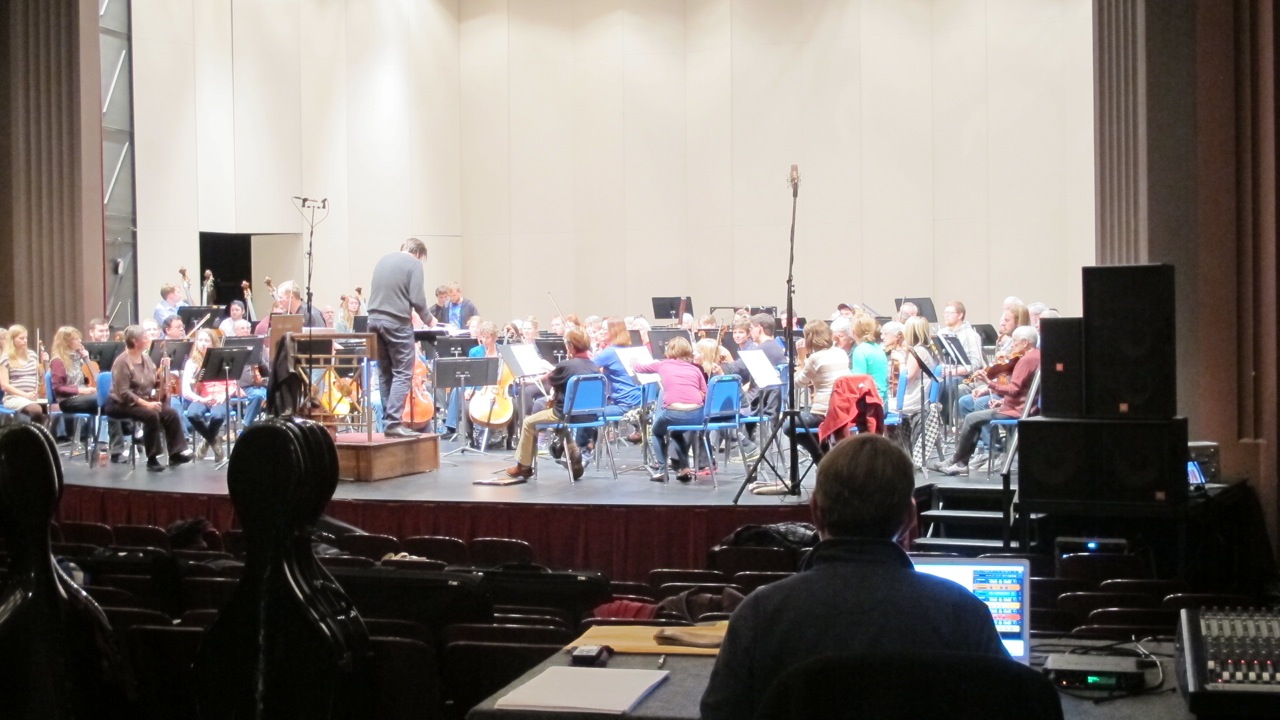
Violist Brett Deubner, conductor Darko Butorac, the Missoula Symphony Orchestra, and composer Charles Nichols performed Nicolo, Jimi, and John at
The Dennison Theatre at the University of Montana in Missoula, MT, November 9-10, 2013
Unimagined Bridges (2011), for band, choir, handbells, and computer-processed sound (7:20)
Score (PDF) | Audio (MP3) | Video (YouTube)
Blacksburg High School Band
Darrell Pearman, director
Blacksburg Middle School Choir
Charlotte McKee, director
with Charles Nichols, computer
In Unimagined Bridges, the percussion section bows and strikes vibraphones, xylophones, tom-toms, and cymbals positioned in stereo on either side of the band, a small choir sings and rings handbells, and the band enters with harmonic washes and melodic fragments, while the computer accompanies with jittery imitations of the acoustic timbres, triggered by the buttons on a MIDI controller, and played through stereo speakers behind the band. Unimagined Bridges was written for the Washington Middle School Band and Choir, and directors was inspired by the poem "As once the winged energy of delight...", by Rainer Maria Rilke.
As once the winged energy of delight
carried you over childhood's dark abysses,
now beyond your own life build the great
arch of unimagined bridges.
Wonders happen if we can succeed
in passing through the harshest danger;
but only in a bright and purely granted
achievement can we realize the wonder.
To work with Things in the indescribable
relationship is not too hard for us;
the pattern grows more intricate and subtle,
and being swept along is not enough.
Take your practiced powers and stretch them out
until they span the chasm between two
contradictions...For the god
wants to know himself in you.
-Rainer Maria Rilke

Unimagined Bridges was performed by
- Washington Middle School Band and Choir, for the University of Montana Concert Band Festival in the Dennison Theatre at the University of Montana, March 1, 2011
- Washington Middle School Band and Choir, on their Spring concert at Washington Middle School in Missoula, MT, June 2, 2011
- Blacksburg High School Band and Blacksburg Middle School Choir, for the Society of Electroacoustic Music in the United States National Conference in the Anne and Ellen Fife Theatre of the Moss Arts Center at Virginia Tech in Blacksburg, VA, March 27, 2015
The Power of Slowing (2010), for wind ensemble (8:00)
Score (PDF) | Audio (MP3): Excerpt
University of Montana Symphonic Wind Ensemble:
James Smart, director
The title and concept for The Power of Slowing is taken from psychiatrist Gerald May’s book The Wisdom of the Wilderness, which discusses the spiritual power of the wild in nature and in ourselves. The outer sections of the piece, filled with syncopated and complex rhythms and halting and interrupting passages, represent the hurry and obsessiveness of daily life, and the central chorale section represents the growing calm from immersing yourself in nature. The piece was written for the University of Montana Symphonic Wind Ensemble and directory James Smart.
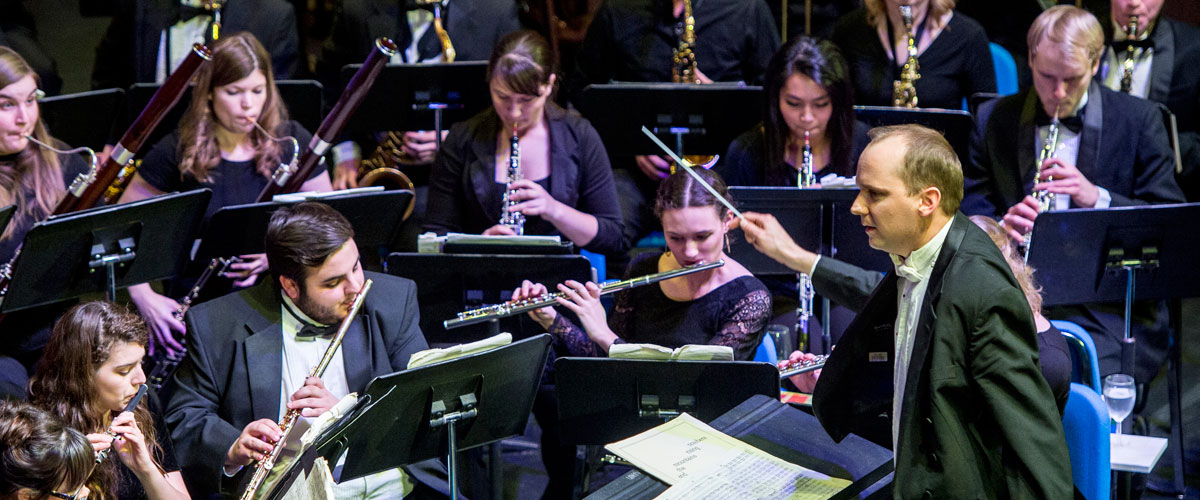
The University of Montana Symphonic Wind Ensemble performed The Power of Slowing at
- University Theater, University of Montana, Missoula, MT, May 5, 2010
Computer Music:
Flutter, Pulse, and Flight (2018), for flute, clarinet, violin, cello, and computer (14:20)
Score (PDF) | Audio (SoundCloud) | Video (YouTube)
Earplay:
Tod Brody, flute
Peter Josheff, clarinet
Terrie Baune, violin
Thalia Moore, cello
Charles Nichols, computer
Flutter, Pulse, and Flight, for flute, clarinet, violin, cello, and computer, is a meditation on love, illness, death, and memory. In the first movement, plaintive melodies are accompanied by fluttering trills in the accompanying instruments. For the second movement, delicate percussive pulses accompany wispy melodies shared between the instruments and computer. Textures in the third movement alternate between frisky interlocking grooves, accompanying stately melodies, and still suspended lines, punctuated with impetuous flourishes. In his electroacoustic chamber music, composer Charles Nichols expands the expressive potential of the ensemble, with interactive computer music programming, that applies audio effects to the acoustic instruments and samples the live performance to play back as accompaniment. For these three movements, the amplified flute, clarinet, violin, and cello are processed with modulation and delay effects, real-time spectral analysis and resynthesis, and live sampling and playback. The piece was commissioned by Earplay, for this premiere performance.

Earplay performed Flutter, Pulse, and Flight at
- Taube Atrium Theater in San Francisco, CA, February 11, 2019
Or Be Forever Fallen (2017), for amplified string quartet and computer (15:20)
Score (PDF) | Audio (SoundCloud) | Video (YouTube) | 360º Video (YouTube)
Beo String Quartet:
Jason Neukom, violin
Sandro Leal Santiesteban, violin
Sean Neukom, viola
Ryan Ash, cello
Zach Duer, video
Charles Nichols, computer
In his recent electroacoustic chamber music, for amplified instruments and computer, composer Charles Nichols has explored a fusion of styles, combining the tradition and craft of classical music with the intensity and bravado of metal. In these pieces, to expand the expressive potential of the acoustic instruments, he combines virtuosic performance with interactive computer music. With Or Be Forever Fallen, he continues that exploration, heavily processing the amplified string quartet with saturated audio effects, including distortion, phasing, and flanging. Believing that classical music can be presented with the same immersive spectacle as popular music, he has collaborated with video artist Zach Duer, who has created animation of imaginary machinery and landscape, tightly coordinated with the music, to be projected behind the spotlighted string quartet.

The Beo String Quartet performed Or Be Forever Fallen at
- Anne and Ellen Fife Theatre of the Moss Arts Center at Virginia Tech in Blacksburg, VA, November 16, 2017
- Sherwood Oaks, Cranberry Township, PA, January 15, 2020
- Steamworks Creative, Gibsonia, PA, January 21, 2020
- on video for the Iowa Composers Forum Digital Summer Festival of New Music, August 29, 2020
Wunderkammer (2016), for oboe, clarinet, bassoon, and computer music (16:50)
Score (HTML) | Audio (MP3) | Video (YouTube)
PEN Trio:
Nora Lewis, oboe
Phillip O. Paglialonga, clarinet
Eric Van der Veer Varner, bassoon
Charles Nichols, computer
Wunderkammer, or cabinets of curiosities, were precursors to museums, collections of natural, cultural, and historical objects, displayed in rooms, owned by aristocrats and scholars. The Oxford Handbook of American Indian History defines the four component categories as Specimens and Curiosities, Instruments of Science, Intricate and Decorative Crafts, and Exotica, which are the inspiration and titles of the four movements. In the piece, the oboe, clarinet, and bassoon are accompanied by computer music, based on recordings of their parts, that freezes the pitches, complements the rhythms, and expands the timbres, of the acoustic instruments.

The PEN Trio performed Wunderkammer at
- Fairmont State University in Fairmont, WV, February 6, 2017
- West Virginia University in Morgantown, WV, February 7, 2017
- Ball State University in Muncie, IN, September 12, 2017
- Western Michigan University in Kalamazoo, MI, September 13, 2017
- Butler University in Indianapolis, IN, September 15, 2017
- Indiana University in Bloomington, IN, September 16, 2017
Published in the PEN Trio Collection by TrevCo Music Publishing, 2018
Epimetheus Gift (2015), for amplified bassoon and computer (7:00)
Score (PDF) | Audio (MP3) | Video (YouTube)
Steve Vacchi, bassoon
Charles Nichols, computer
Epimetheus Gift, for amplified bassoon and computer, uses heavily processed rhythmically dense bassoon lines, accompanied by pattern gated granular synthesis, hammered chords, and pulsing delays of sampled bassoon notes and breath, spread across immersive spatial audio, to surround the audience in intense musical textures, inspired by the Swedish extreme metal band Meshuggah. The piece was written for Steve Vacchi, with a commission from the University of Oregon, and was premiered in 134.1 channels of the 3D spatial audio system in the Cube of the Moss Arts Center at Virginia Tech.

Bassoonist Steve Vacchi performed Epimetheus Gift at
- DISIS Concert in Blacksburg, VA, May 2, 2016
- Society for Electroacoustic Music in the United States National Conference in Saint Cloud, MN, April 20, 2017
- Birmingham Electroacoustic Sound Theatre Festival (BEAST FEaST) in Birmingham, UK, April 29, 2017
At the Boundary (2014), for string quartet and computer (10:50)
Score (PDF) | Audio (MP3): Beo String Quartet | Video (YouTube): Beo String Quartet | Video (YouTube): Flux Quartet
Beo String Quartet:
Jason Neukom, violin
Sandro Leal Santiesteban, violin
Sean Neukom, viola
Ryan Ash, cello
FLUX Quartet:
Tom Chiu, violin
Conrad Harris, violin
Max Mandel, viola
Felix Fan, cello
Charles Nichols, computer
At the Boundary, for amplified string quartet and computer, searches for the border between technically challenging music, with complex rhythms, angular melodies, and dissonant harmonies, and music that is fun to play and hear. It was inspired by the string quartets of Bartók and Shostakovich, and the Swedish Metal band Opeth, and is infused with anxiety about the political military conflict in the Ukraine. In the four attacca movements, the string instruments accompany arching sustained melodies and countermelodies, with driving rhythmic spiccato, half col legno, pizzicato, and flautando passages. Interactive computer programming, controlled by a computer musician, expands the timbres of the amplified string instruments, with delay, phaser, fuzz, and flanger effects. Following the quartet, the computer musician triggers delays of different rhythm and duration, phasers and flangers of different speed and depth, and fuzz distortion of different loudness and brightness. The piece was commissioned by the Third Angle Ensemble, for their New Ideas in Music concert.
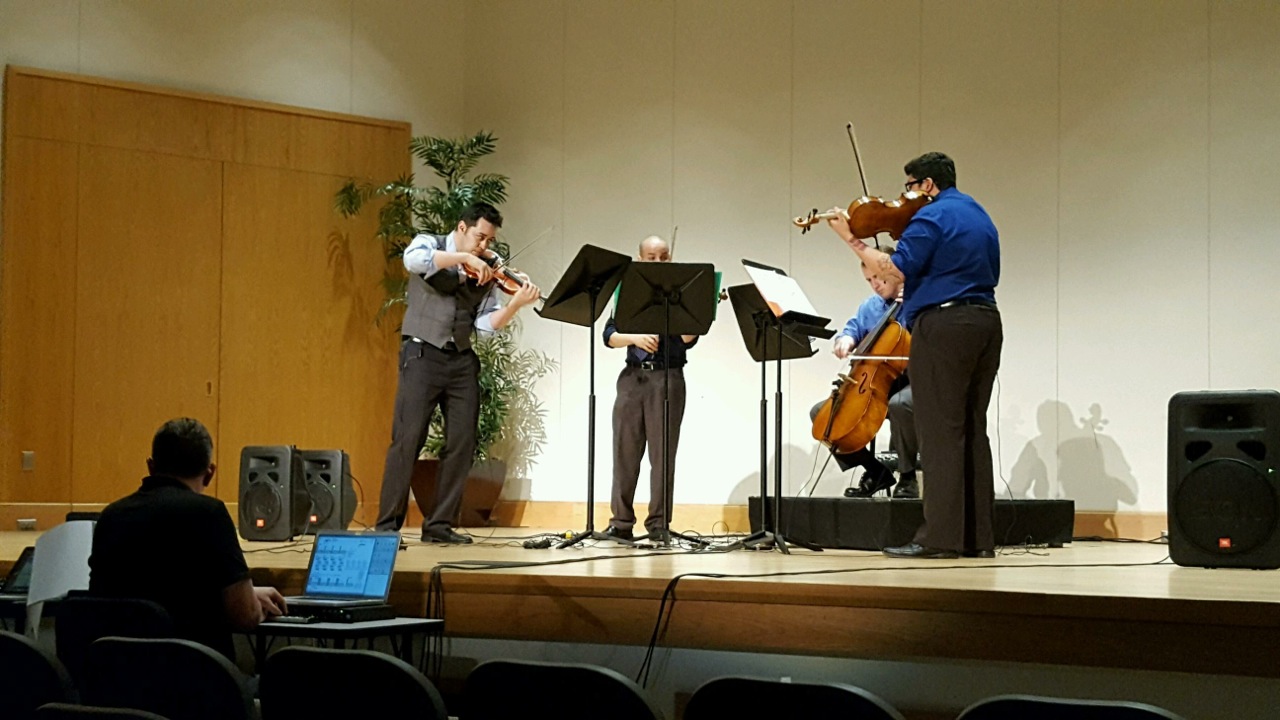
At the Boundary was performed by
- Third Angle String Quartet, violinists Ron Blessinger and Peter Frajola, violist Charles Noble, and cellist Marilyn DeOliveira, on their New Ideas in Music concert at the Alberta Rose Theatre in Portland, OR, May 23, 2014
- Violinists Tatiana Karpova and Judy Meister, violist Kirsten Swanson, and cellist Tanja Bechtler, at the College Music Society Mid-Atlantic Regional Conference at Winthrop University in Rock Hill, SC, February 26, 2016
- FLUX Quartet, with violinists Tom Chiu and Conrad Harris, violist Max Mandel, and cellist Felix Fan, in the Recital Salon at Virginia Tech in Blacksburg, VA, March 28, 2016
- Klang String Quartet, violinists Gregor Kitzis and Funda Cizmecioglu, violist Tina Chang-Chien, and cellist Arthur Cook, at the NY Phil Biennial concert of the New York City Electronic Music Festival at National Sawdust in Brooklyn, NY, June 5, 2016
- Beo String Quartet, with violinists Jason Neukom and Sandro Leal Santiesteban, violist Sean Neukom, and cellist Ryan Ash, at the Charlotte New Music Festival in Charlotte, NC, June 10, 2016
Il Prete Rosso (2013), for amplified violin, motion sensor, and computer (6:05)
Score (PDF) | Audio (MP3) | Video (YouTube)
Sarah Plum, violin
Charles Nichols, computer
Il Prete Rosso, for amplified violin, motion sensor, and computer, was inspired by the violin concertos of Italian Baroque composer and virtuoso violinist Antonio Vivaldi, who was nicknamed The Red Priest, because of his red hair and Catholic ordination. In the piece, the amplified violin is recorded live and played back in four parts, spatialized around the audience, as an accompaniment with itself. A motion sensor on the wrist of the violinist tracks bow arm performance gesture, to interactively control audio effects in the computer. The piece was written for Sarah Plum, with a commission from Drake University. The full premiere was performed with the new 124.4 channel 3D surround-sound system, installed in the Cube of the Moss Arts Center at Virginia Tech.

Violinist Sarah Plum performed Il Prete Rosso at
- Third Practice Festival in Richmond, VA, November 8, 2014
- University of North Carolina in Greensboro, NC, November 11, 2014
- Cube of the Moss Arts Center at Virginia Tech University in Blacksburg, VA, December 1, 2014
- Santa Clara University in Santa Clara, CA, May 13, 2015
- San Francisco State University in San Francisco, CA, May 15, 2015
- Center for New Music in San Francisco, CA, May 19, 2015
- Spectrum in New York, NY, June 25, 2015
- New York City Electronic Music Festival at the Abrons Arts Center in New York, NY, June 26, 2015
- International Computer Music Conference in Denton, TX, September 25, 2015
- College Music Society National Conference in Indianapolis, IN, November 5, 2015
- Society of Composers Inc. National Conference in Gainesville, FL, November 14, 2015
- Society of Electroacoustic Music in the United States National Conference in Statesboro, GA, February 11, 2016
- SummerMusic in Sheslow Auditorium at Drake University in Des Moines, IA, September 28, 2016
- SummerMusic in Mary Ellen Tye Recital Hall at Iowa State University in Ames, IA, September 30, 2016
- CCRMA Stage at Stanford University in Stanford, CA, October 5, 2016
- Electronic Music Midwest at Lewis University in Romeoville, IL, October 14, 2016
To be released on the Personal Noise CD (2019), Sarah Plum, Blue Griffin Recording
Released on the Computer Music Journal Sound and Video Anthology (2017), MIT Press, Computer Music Journal Volume 41, Issue 1
Multiplication of Machines (2010), for flute, clarinet, violin, cello, piano, and computer
Score (PDF)
- I. Pistons, for solo violin and computer (4:29)
Audio (MP3) | Video (YouTube) | Video (YouTube) - II. Valves, for flute, clarinet, and computer (4:43)
- III. Springs, for violin, cello, piano, and computer (5:20)
Video (YouTube) - IV. Circuits, for flute, bass clarinet, violin, cello, piano, and computer (4:50)
- V. Gears, for clarinet, violin, piano, and computer (9:12)
- VI. Pendulum, for solo clarinet and computer (4:05)
Audio (MP3)
Darragh Morgan, violin
Kandinsky Trio:
Benedict Goodfriend, violin
Alan Weinstein, cello
Elizabeth Bachelder, piano
Third Angle Ensemble:
GeorgeAnne Ries, flute
Todd Kuhns, clarinet
Ron Blessinger, violin
Hamilton Cheifetz, cello
Susan Smith, piano
with Charles Nichols, computer
Arianna Tieghi, clarinet
Charles Nichols, computer
The springboard for Multiplication of Machines was a passage from Luigi Russolo's manifesto, L'arte dei Rumori (The Art of Noises), in which the Italian Futurist writes, "At first the art of music sought purity, limpidity and sweetness of sound. Then different sounds were amalgamated, care being taken, however, to caress the ear with gentle harmonies. Today music, as it becomes continually more complicated, strives to amalgamate the most dissonant, strange and harsh sounds. In this way we come ever closer to noise-sound. This musical evolution is paralleled by the multiplication of machines, which collaborate with man on every front." In the six movements, each for various combinations of flute, clarinet, violin, cello, and piano, interactive computer-processing is used to accompany or expand the timbral possibilities of the musical instruments, at times recording and looping passages, or modulating, filtering, and delaying instruments. Each movement is a musical machine, in which the performer emulates the auditory expression of mechanical components, such as pistons, valves, springs, circuits, gears, and a pendulum; the performer brings to life the expressive potential of these machines. Multiplication of Machines was commissioned by the Myrna Loy Center for the Performing and Media Arts and written for the Third Angle Ensemble.
For I. Pistons, the solo violin is periodically recorded and looped at different speeds in four channels. In II. Valves, the flute and clarinet are convolved with one another in two channels, and with looped live recordings in two channels, producing ringing effects. For III. Springs, hocketing rhythms are progressively built in pattern gates in two channels, that pulse the resonance of a reverb applied to the instruments. In IV. Circuits, auto-wah and octave doubling are applied to all instruments separately, and the effects increase throughout the movement. For V. Gears, a tremolo that gradually increases in frequency, a flanger that progressively changes depth, and a delay that increases in speed, are applied to the three instruments, each effect corresponding to a different motive. In VI. Pendulum, the solo clarinet is echoed at different speeds in four channels, each speed corresponding to a different strata of the contrapuntal line.

The Third Angle Ensemble performed Multiplication of Machines at
- Old Church in Portland, OR, May 7, 2010
- Myrna Loy Theatre in Helena, MT, August 2, 2010
- Recital Hall at the University of Montana in Missoula, MT, October 5, 2012
Violinist Darragh Morgan performed I. Pistons at
- International Computer Music Conference in Huddersfield, England, August 1, 2011
- DISIS Concert in the Cube of the Moss Arts Center at Virginia Tech in Blacksburg, VA, May 7, 2019
Clarinetist David Niethamer performed VI. Pendulum at
- Third Practice Festival, Booker Hall, University of Richmond, Richmond, VA, November 6, 2010
Clarinetist Arianna Tieghi performed VI. Pendulum at
- International Summer Arts Institute in Città di Castello, Italy, July 6, 2012
- International Summer Arts Institute in Città Rome, Italy, July 11, 2012
The Temple New Music Ensemble performed IV. Circuits at
- Rock Hall at Temple University in Philadelphia, PA, October 20, 2014
The Kandinsky Trio performed I. Pistons, III. Springs, and I. Pendulum at
- Olin Hall Theater at Roanoke College in Salem, VA, September 14, 2019
Cellist Alan Weinstein performed I. Pendulum at
- DISIS Concert in the Cube of the Moss Arts Center at Virginia Tech in Blacksburg, VA, December 9, 2019
Chamber Music:
In Gratitude (2019), for string quartet (9:40)
Score (PDF)
Charles Castleman, violin
John Irrera, violin
Molly Wilkens-Reed, viola
Alan Weinstein, cello
In Gratitude is an autobiographical meditation on the impact violinist and pedagogue Charles Castleman has had on the life and work of the composer.
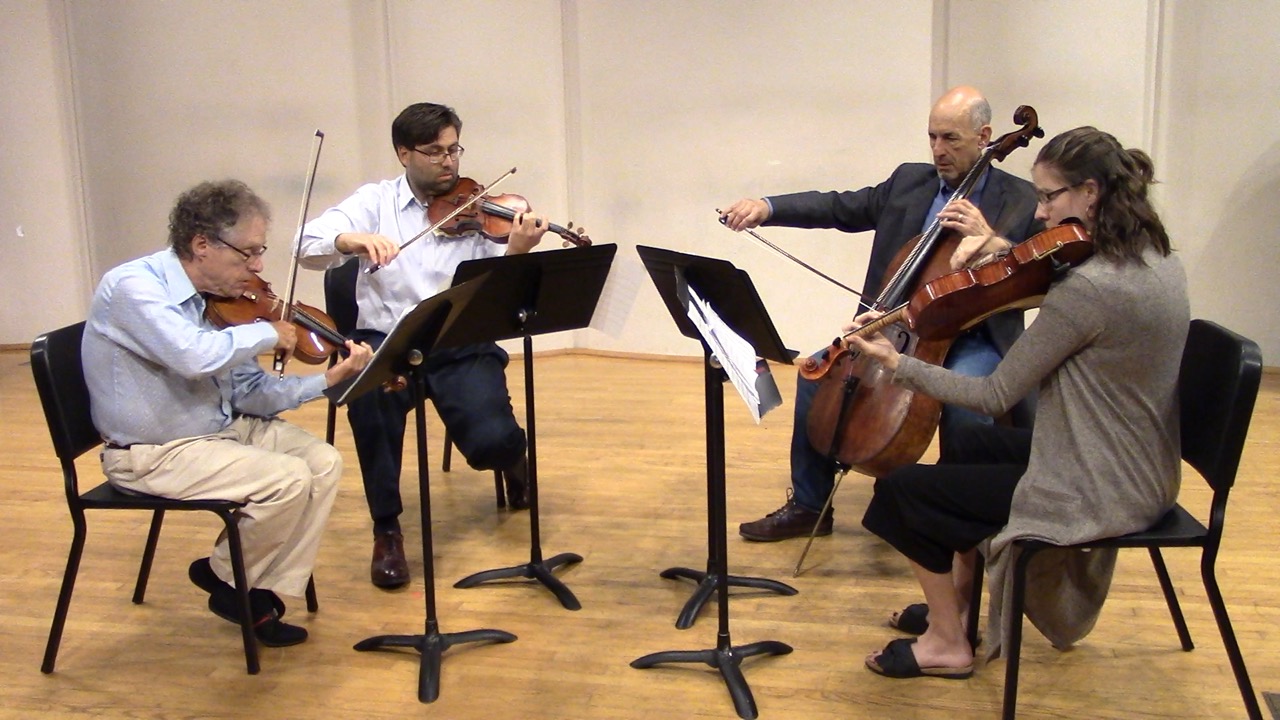
Charles Castleman, John Irrera, Molly Wilkens-Reed, and Alan Weinstein performed In Gratitude at
- Recital Salon at Virginia Tech in Blacksburg, VA, October 15, 2019
- Eastern Divide in Blacksburg, VA, October 16, 2019
The Beo String Quartet performed Or Be Forever Fallen: III. Peaceful, Flowing, Reflective
- streamed from Pittsburg, PA for the Charlotte New Music Festival, June 26, 2020
- on video for the Iowa Composers Forum Digital Summer Festival of New Music, August 30, 2020
It does not shy away from the sword (2019), for bass clarinet and marimba (6:30)
Score (PDF) | Video (YouTube)
Transient Canvas:
Amy Advocat, bass clarinet
Matt Sharrock, marimba
It does not shy away from the sword is a meditation on quiet perseverance in the face of adversity.
“It laughs at fear, afraid of nothing; it does not shy away from the sword. The quiver rattles against its side, along with the flashing spear and lance. In frenzied excitement it eats up the ground; it cannot stand still when the trumpet sounds. At the blast of the trumpet it snorts, 'Aha!' It catches the scent of battle from afar, the shout of commanders and the battle cry.”

Transient Canvas performed It does not shy away from the sword at
- Charlotte New Music Festival in Bryant Hall in Charlotte, NC, June 21, 2019
Bluestone (2018), for alto saxophone, electric guitar, piano, and drum set (4:50)
Score (PDF) | Audio (MP3) | Video (YouTube)
Hypercube:
Erin Rogers, alto saxophone
Jay Sorce, electric guitar
Andrea Lodge, piano
Chris Graham, drum set
The Bluestone River flows through the beautiful wilderness of West Virginia and the blight of urban decay left behind by the demise of the coal industry. Sprinkled along the river bank, between pristine forests and majestic canyons, are abandoned towns and houses torched in desperation.

The Hypercube ensemble performed Bluestone at
- Charlotte New Music Festival in Myers Park Presbyterian Church in Charlotte, NC, June 29, 2018
Tsuga (2018), for solo piano (8:30)
Score (PDF) | Audio (MP3) | Video (YouTube)
Richard Steinbach, piano
In the tradition of 24 Little Pieces by Dmitri Kabalevsky and Little Piano Book by Vincent Persichetti, Tsuga is a concert piece for solo piano at the intermediate level. Inspired by the hemlock trees in the mountains of West Virginia, a majestic species that is under attack by a non-native insect, dying in large numbers, and recovering as new saplings grow, the composition moves through three attacca movements, each a different treatment of the melodic and harmonic material. This work was jointly commissioned by the Iowa Music Teachers Association and Music Teachers National Association in 2018, as a result of a competition cosponsored by the Iowa Composers Forum, and was premiered by Richard Steinbach on June 3, 2018 in Iowa City, Iowa.

Richard Steinbach performed Tsuga at
- Iowa Music Teachers Association Annual State Conference in Voxman Concert Hall at the University of Iowa in Iowa City, IA, June 3, 2018
In the waiting room of America (2017), for baritone voice, trumpet, trombone, and bass clarinet (4:20)
Score (PDF) | Audio (MP3) | Video (YouTube)
loadbang:
Jeffrey Gavett, baritone voice
Andy Kozar, trumpet
William Lang, trombone
Carlos Cordeiro, bass clarinet
Erika Meitner, poetry
In the Waiting Room of America is a setting of a poem written by Erika Meitner, that explores anxiety about the current political climate. The music reflects this fear, with frantic arpeggiation and pulsing bass, accompanying an angular vocal line in multiple registers and sustained countermelodies.
In the waiting room of America
the television says, will restore your tarnished silver,
says Rainbrella: wipe on, wipe off. It’s six minutes
before Armageddon, before senators vote on something
and I’m sitting in a long row of chairs at the eye doctor
with old farmers, one in denim overalls with a giant
wooden rubber-tipped walking stick that has Bobby
carved into one end. It rests between his legs. The TV
says, if you’re age fifty to eighty-five I want to talk to you
about security. In the waiting room of America there’s
a woman in a white cardigan whose eye is more inflamed
than mine. Her husband holds her arm and looks concerned.
We are all limping along and subject to news and products.
One of the good ones. America, you are growling. America,
I call my representative every morning, but he doesn’t
hear me when I speak. It’s downright dangerous, warns
a man on screen before it cuts to a re-run of MASH—
who doesn’t recognize that theme song? They’re calling
our names one by one and the room is emptying to whirring
helicopters, to a laugh track. Bobby leans hard on his tall
stick to hoist himself up. It’s your turn, America, and beside
the television is an abstract flag woven from bent metal strips.
Has your insurance changed? There are so many ways to be
angry. Dissatisfied. To reach for the firmament and fall short.
To need help. I had no idea! This is what I’m made of. Ancestry
DNA. The ads keep playing. You can easily apply in a single
phone call. You cannot be turned down. And then MASH again—
Alan Alda in his fatigues—America, you’re bleeding internally.
We’re going to have to operate.
-Erika Meitner

loadbang performed In the Waiting Room of America at
- Charlotte New Music Festival in Rowe Recital Hall at the University of North Carolina in Charlotte, NC, June 26, 2017
What we think of, when we think about ourselves, is a story. (2016), for solo piano (7:00)
Score (PDF) | Audio (MP3) | Video (YouTube)
Richard Masters, piano
What we think of, when we think about ourselves, is a story. explores the idea that not only do we require language to understand complex concepts like spatial reasoning, but that the running dialogue in our mind defines our reality, that is likely different from those around us. The piece was written for Richard Masters, who has performed it in Virginia, Massachusetts, and Trinidad and Tobago.

Pianist Richard Masters performed What we think of, when we think about ourselves, is a story. at
- Lambda Horizon Scholarship Fundraiser at the Unitarian Universalist Congregation in Blacksburg, VA, February 20, 2016
- San Fernando Campus of the University of Trinidad and Tobago, March 2, 2016
- Curry College in Boston, MA, March 10, 2016
- Brookline Library Artist Series in Brookline, MA, March 13, 2016
- Music on Mondays Concert Series in the Recital Salon at Virginia Tech in Blacksburg, VA, March 28, 2016
Commencement Address (2014), for double brass quintet (5:15)
Score (PDF)
Virginia Tech Brass Ensemble
Commencement Address moves the listener through the emotional states experienced during graduation, such as triumph, celebration, reflection, reminiscence, resolution, joy, introspection, confidence, jubilation, and revelation, with melodies and accompanimental figures that pass between the four trumpets, double horns, trombones, and tubas. The piece was commissioned by the Virginia Tech Graduate School, for the annual Graduate School Commencement Ceremony.

The Virginia Tech Brass Ensemble performed Commencement Address at
- Graduate School Commencement Ceremony in Cassell Coliseum at Virginia Tech in Blacksburg, VA, May 12, 2016
- Graduate School Commencement Ceremony in Cassell Coliseum at Virginia Tech in Blacksburg, VA, December 18, 2015
- Graduate School Commencement Ceremony in Cassell Coliseum at Virginia Tech in Blacksburg, VA, May 15, 2015
- Graduate School Commencement Ceremony in Cassell Coliseum at Virginia Tech in Blacksburg, VA, December 19, 2014
Mountain Dance Suite: II. Tango at the Downtown Dance Collective (2012), for clarinet, violin, and piano (7:20)
Score (PDF) | Audio (MP3) | Video (YouTube)
Phillip Paglialonga, clarinet
Nicole Paglialonga, violin
Tracy Cowden, piano
Mountain Dance Suite explores different genres of dance performed in mountain states. The first movement, I. Step-Dancing at the M&M, was a collaboration with choreographer Jane Comfort, and was premiered by the Sapphire Trio and Headwaters Dance Company, who commissioned the work. The second movement, II. Tango at the Downtown Dance Collective was commissioned by the Montana State Music Teachers Association, and written at the Ucross Artist Retreat for the Sapphire Trio.

Mountain Dance Suite: II. Tango at the Downtown Dance Collective was performed by
- Sapphire Trio, Montana State Music Teachers Association State Conference, Kalispell, MT, November 4, 2012
- Phillip Paglialonga, Nicole Paglialonga, and Tracy Cowden, Music on Mondays Concert Series, Recital Salon, Virginia Tech, Blacksburg, VA, March 28, 2016
Så Vadå (2011), for alto saxophone and bass clarinet (6:00)
Score (PDF) | Audio (MP3)
Namaste Ensemble:
Michele Bianchini, alto saxophone
Guido Arbonelli, bass clarinet
Så Vadå, Swedish for "So What", is based on the two chord progression used by Miles Davis, for his Jazz standard of the same name. A pulsing syncopated rhythmic motive, that moves between the pitches of the chords, is passed between the alto saxophone and bass clarinet, accompanying a sweeping melody, that is first introduced in fragments. Later, the pulsing chords are stretched into sustained counterpoint, interrupting the flow of the melody. After several sputters, the piece regroups, ending with the same buoyant energy as at the beginning.

Så Vadå was performed by
- Johan Eriksson and Chris Kirkpatrick, University of Montana, Missoula, MT, March 12, 2011
- Namaste Ensemble, International Summer Arts Institute, Città di Castello, Italy, July 5, 2012
- Johan Eriksson and Chris Kirkpatrick, North American Saxophone Alliance Conference, Missoula, MT, October 23, 2012
To be released on the Duo Nyans CD (2018), Duo Nyans: Christopher Kirkpatrick, clarinets, Johan Eriksson, saxophones
Released on The Namaste Ensemble: No Borders Quartet, "In Memoriam Dinu Ghezzo" CD (2013), International Arts Educators Forum and International Composers Interactive Artists
The Blues is Crying (2010), for solo viola
Score (PDF) | Audio (MP3) | Video (YouTube)
Brett Deubner, viola
The Blues Is Crying was inspired by the virtuosity of guitar legend Stevie Ray Vaughan, specifically his song The Sky Is Crying. For this virtuosic piece, Vaughan's style and technique were extracted from the aesthetic of a Texas blues band, and abstractly applied to solo viola in a concert music context.

Violist Brett Deubner performed The Blues Is Crying at
- Sioux City Chamber Music Association in Sioux City, IA, November 21, 2010
- Bowling Green State University in Bowling Green OH, April 22, 2011
Fixed Media:
Shakespeare’s Garden (2018), for processed environmental sounds and recited poetry, accompanying projected graphic design and theatrical lighting (continuous)
Video (YouTube)
Amanda Nelson and Natasha Staley, directors
Meaghan Dee, graphic design
John Ambrosone, lighting
Tanner Upthegrove, media engineering
Shakespeare’s Garden is an immersive art installation for processed field recordings of nature soundscapes of four seasons played through a spatial audio system, recorded actors reciting sonnets and soliloquies played through directional spotlight speakers, and projected graphic design of poetry mapped to custom scrims, to create an immersive user-directed multimedia theater experience. As visitors stroll through the soundscapes and around the graphic design projections, they step into theatrically lit spots, where only they can hear the actors reciting sonnets, soliloquies, and scenes played through directional spotlight speakers.
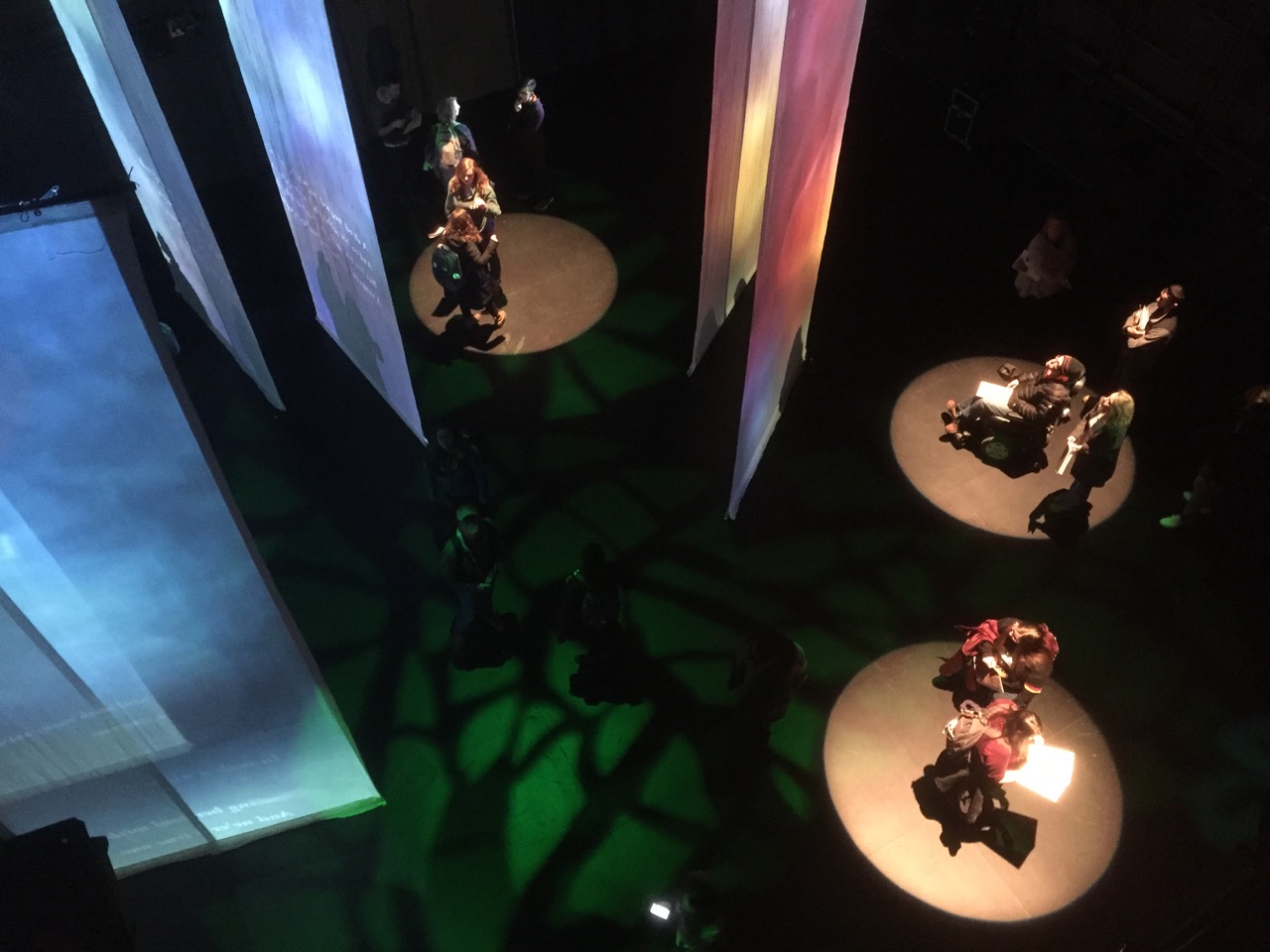
Shakespeare’s Garden was presented at
- Cube, Moss Arts Center, Virginia Tech, Blacksburg, VA, March 22-24, 2018
- Audio Engineering Society International Conference on Spatial Reproduction, 100th Anniversary Hall, Tokyo Denki University and Studio B, Tokyo University of the Arts, Tokyo, Japan, August 8-9, 2018
- ACCelerate Smithsonian Creativity and Innovation Festival, National Museum of American History, Washington, DC, April 5-7, 2019
Underlying Space (2017), for recorded processed electric violin, accompanying the art installation 30x30 (30:35)
Audio (MP3) | Video (YouTube)
Paola Zellner Bassett, installation art
The art installation 30x30 celebrates the work of the International Archive of Women in Architecture, by showcasing thirty women architects, projecting on two perpendicular screens, details of their lives and work, each for five minutes, running in a continuous loop. The composition Underlying Space accompanies the art installation, with patient ambient textures of recorded violin pizzicati, trills and sustained tones, processed with multiple delays and reverbs, producing an ethereal soundscape.

30x30 with Underlying Space was presented at
- AIA Women in Leadership Summit at the American Institute of Architects National Headquarters in Washington, DC, September 11, 2017 to February 5, 2018
- Kibel Gallery in the School of Architecture, Planning and Preservation, at the University of Maryland in College Park, MD, September 18, 2017 to February 5, 2018
Beyond the Dark (2016), for computer music, accompanying the art installation Dense Space (22:00)
Audio (MP3) | Video (YouTube)
Paola Zellner Bassett, installation art
For the Dense Space art installation, by architect Paola Zellner Bassett, Charles Nichols composed Beyond the Dark, a multichannel piece of synthesized sound that continuously loops, spatialized in surround sound around the gallery. Layers of low pulsing textures, that oscillate through the harmonic series and sonify space weather data with sweeping filters, accompany sustained melodies, punctuated by pulsing bursts, that drift through the spatial audio system. The piece immerses the listener in waves of saturated sound, inspired by the depth of space and the interplay between gravitational bodies.

Dense Space with Beyond the Dark was presented at
- ACCelerate Smithsonian Creativity and Innovation Festival at the National Museum of American History in Washington, DC, October 13-15, 2017
- DISIS Concert in the Cube of the Moss Arts Center at Virginia Tech in Blacksburg, VA, December 11, 2017
- Science Museum of Western Virginia in Roanoke, VA, January 22, 2018 to present
- International Computer Music Conference, Lotte Facade, Daegu, Korea, August 6-10, 2018
- Audio Engineering Society International Conference on Spatial Reproduction, 100th Anniversary Hall, Tokyo Denki University and Studio B, Tokyo University of the Arts, Tokyo, Japan, August 8-9, 2018
Describe the Sky to Me (2016), for processed environmental sounds, accompanying installation art (continuous)
Marie Yoho Dorsey, performance and installation art
For the art installation Describe the Sky to Me, Charles Nichols assembled and programmed a Raspberry Pi computer music system, that continuously played randomly chosen soundfiles, of granulated eagle, hawk, owl, and wren bird call recordings, over melodies filtered from wind and rain recordings. The audio output from the Raspberry Pi was played through a multichannel audio interface through stereo amplifiers to six car sound system speakers, embedded in the installation art.

Describe the Sky to Me was presented at
- Anderson Ranch Art Center in Snowmass Village, CO, March 12 to April 8, 2016
- Art in the Open at Schuylkill Banks in Philadelphia, PA, May 15, 2016
Kimono Layers (2013), for recorded processed electric violin, accompanying video of performance art (3:30)
Video (YouTube)
Marie Dorsey, performance art
Kimono Layers, for recorded electric violin and video of performance art, is a collaboration between musician Charles Nichols and performance artist Marie Yoho Dorsey.

Kimono Layers was presented at
- Dairy Center for the Arts, Denver, CO, May 23 - July 9, 2014
This Edge (2013), for processed environmental sounds, accompanying video (5:00)
Video (YouTube)
Joan Grossman, video
This Edge is a multimedia collaboration, between composer Charles Nichols and video artist Joan Grossman. The five sections of the piece were originally atmospheric interludes, between interviews of artists talking about creativity, in a video installation projected on four screens, for the opening of the Cube in the Moss Arts Center at Virginia Tech. Selected from ten original interludes, these five were assembled into an independent piece of ambient computer music and video.

This Edge was presented at
- Cube, Moss Arts Center, Virginia Tech, Blacksburg, VA, October 28 - November 24, 2013
- New York City Electronic Music Festival, Abrons Arts Center, New York, NY, June 28, 2015
- Festa Europea Della Musica, University of Rome "Tor Vergata", Rome, Italy, July 3, 2015
- International Composers and Interactive Artists Concert, Foundation for Emerging Technologies and Arts 12 Nights Concert Series, Center for Visual Communication Project Space, Miami, FL, October 17, 2015
Sound of Rivers: Stone Drum (2013), for recorded processed electric violin, sonified data, and processed narrated poetry, accompanying animation and processed video of dance (5:00)
Video (YouTube)
Nicole Bradley Browning, choreography
Amber Bushnell, animation and processed video
Mark Gibbons, poetry and narration
Allison Herther, dance
Charles Nichols, electric violin and computer music
Sound of Rivers: Stone Drum is the fixed media version of a multimedia collaboration between a choreographer, animator, poet, dancer, narrator, scientist, and composer, that illuminates research into how insects navigate the ecosystem of floodplains, by the sound of rivers.
Sound of Rivers: Stone Drum is based on work supported by the Montana Institute on Ecosystems award from NSF EPSCoR Track-1 (INSTEP 3) program under Grant # EPS-1101342 at the University of Montana.

Sound of Rivers: Stone Drum was presented as fixed media at
- DISIS Event for ICAT Day in the Cube at Virginia Tech in Blacksburg, VA, February 17, 2014
- EcoSono Biomes Concert at California State University in Fullerton, CA, March 1, 2014
- Society for ElectroAcoustic Music in the United States National Conference in Middletown, CT, March, 28, 2014
- New York City Electronic Music Festival at the Abrons Arts Center in New York, NY, June 4, 2014
- Charlotte New Music Festival in Charlotte, NC, June 14, 2014
- Festa Della Musica Europa at the University of Rome "Tor Vergata" in Rome, Italy, June 19, 2014
- Big Sky Alive Festival in Helena, MT, June 23, 2014
- Australasian Computer Music Conference at the Victorian College of the Arts in Melbourne, Australia, July 10, 2014
- International Computer Music Conference at Odeon Starcity in Athens, Greece, September 19, 2014
- TripleCCRMA Festival at CCRMA Stage at Stanford University in Stanford, CA, October 27, 2014
- Sonic Voyages: Surprise in the Bristol University Loudspeaker Orchestra in Bristol, England, December 5, 2014
- Poznan Music Spring International Festival in Poznan, Poland, March 29, 2015
- FETA 12 Nights concert series at the Center for Visual Communication Project Space in Miami, FL, October 17, 2015
- Sunday Night Multimedia Series in Reynolds Recital Hall at Montana State University in Bozeman, MT, October 20, 2019
Structured Improvisation:
Meadows of Dan (2019), for amplified trombone and computer (variable)
Score (PDF) | Video (YouTube)
William Lang, trombone
Charles Nichols, computer
Meadows of Dan is a structured improvisation for trombone and computer in an immersive spatial audio system, where the computer musician captures the amplified trombone with spatialized live sampling and playback. The piece was written for trombone virtuoso William Lang.
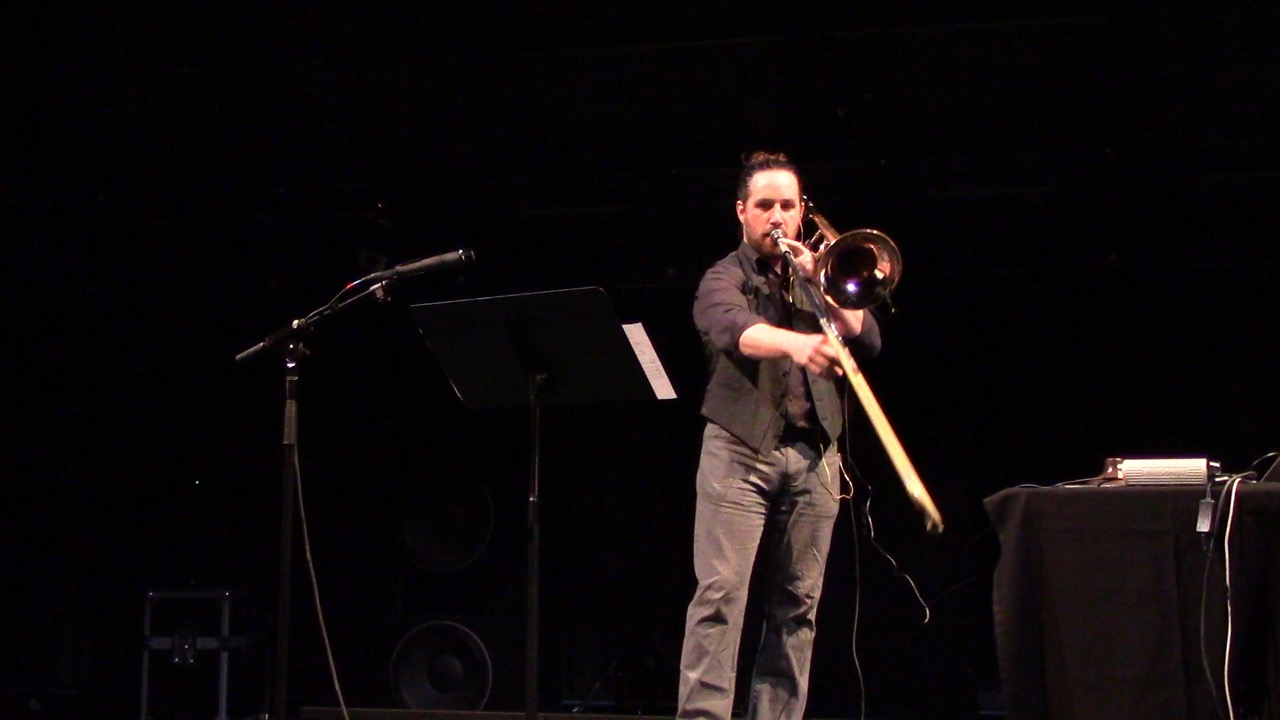
Trombonist William Lang performed Meadows of Dan at
- Music on Mondays in the Cube of the Moss Arts Center at Virginia Tech in Blacksburg, VA, April 8, 2019
Badstar (2018), for electric violin, electric banjo, electric guitar, electronic drums, and computers in 134.2-channel spatial audio with multiple projections of interactive processed video mapped to custom architecture (~60:00)
Charles Nichols, electric violin, computer, and composition
Holland Hopson, electric banjo, computer, and composition
André Foisy, electric guitar, computer, and composition
Denver Nuckolls, electronic drums
Zach Duer, interactive processed video
Jon Rugh, projection mapping architecture
Badstar is an hour show in three movements, that premiered in the Cube of the Moss Arts Center at Virginia Tech. Badstar features music inspired by fusion, old-time, noise, and drone metal, collaboratively composed by Charles Nichols, Holland Hopson, and André Foisy, performed on processed electric violin, electric banjo, electric guitar, and computers, and with Denver Nuckolls on electronic drums, in immersive spatial audio, with multichannel processed video, performed by Zach Duer and interactive with the music, projected on custom architecture surrounding the audience, designed and constructed by Jon Rugh. The project was supported by an Institute for Creativity, Arts, and Technology SEAD (Science, Engineering, Art, and Design) Major Initiative Program grant.

Charles Nichols, Holland Hopson, André Foisy, Denver Nuckolls, and Zach Duer performed Badstar at
- Cube of the Moss Arts Center at Virginia Tech in Blacksburg, VA, October 11-13, 2018
Traffic Sonata (2018), for amplified violin, oud, and qanun, sonified traffic data, and traffic simulations (variable)
Video (YouTube)
Charles Nichols, violin and computer
Montasir Abbas, oud
Anne Elise Thomas, qanun
The Traffic SONATA (Traffic Signal Operation with Neuro-fuzzy Acoustic Tuning Applications) project aims to apply principles of musical improvisation to traffic flow. By creating protocols through which traffic data is turned into sound (a process known as "sonification"), and by which musicians are able to affect the flow of traffic through musical action and interaction, we offer an innovative perspective on transportation research and ultimately hope to contribute to developing more optimal systems of traffic control.

Traffic Sonata was performed and presented as fixed media at
- ICAT Day, Francis T. Eck Exhibition Corridor, Moss Arts Center, Virginia Tech, Blacksburg, VA, April 30, 2018
- ICAT: Open (at the) Source: Trace, Francis T. Eck Exhibition Corridor, Moss Arts Center, Virginia Tech, Blacksburg, VA, April 30 - June 9, 2018
- DISIS Concert, Cube, Moss Arts Center, Virginia Tech, Blacksburg, VA, May 1, 2018
What Bends (2017), for electric violin, sonified data, and computer music, with narrated poetry, motion capture dance, animation, and processed video (~30:00) or for electric violin, computer music, and video (~7:00)
Video (YouTube)
Zach Duer, video
Erika Meitner, poetry and narration
Charles Nichols, electric violin and computer
Rachel Rugh, choreography and dance
with Katy Gaines, Eric Mullis, and Barbara Tait, dance
What Bends is a multimedia collaboration that explores life in Appalachia, with electric violin, sonified data, interactive computer music, narrated poetry, dance, animation, and processed video, performed in 134-channel spatial audio, 360° immersive video, and 24-camera motion capture. In the first movement, the electric violin, processed with computer effects, plays echoing pizzicato, harmonic glissando, and tremolo motives, as the dancers enter, then live samples looping counterpoint in four parts, transposed down one and two octaves, for the third and fourth parts. After the samples are played together in time, the loops are progressively shortened, to glitch the rhythm, and playback speed is doubled and halved, to transpose the pitch. As the loops rotate at different heights of the spatial audio system, the movement ends with a return to the opening pizzicato motive, played over the fading samples. For the second movement, loops of the narrated poetry, echoing at different speeds, are assembled into a rap of interlocking rhythms, that hocket around the spatial audio system, increasing in activity and density. For the third movement, mandolin recordings are assembled into looping four part counterpoint, similar to the violin lines in the first movement, and gradually disintegrate into sound particles and freeze into blur. The looping textures shoot across the spatial audio system, controlled by 3D printed motion capture rings, designed by the composer, worn by the solo dancer. At the same time, the dancer progressively uncovers the ambient surround video, by erasing a shroud with the rings. The piece was premiered in conjunction with the Appalachian Studies Conference, in the Cube of the Moss Arts Center at Virginia Tech.

What Bends was performed and presented as fixed media at
- "Extreme Appalachia" Appalachian Studies Conference in the Cube of the Moss Arts Center at Virginia Tech in Blacksburg, VA, March 11, 2017
- DISIS Anniversary Concert in the Cube of the Moss Arts Center at Virginia Tech in Blacksburg, VA, May 1, 2017
- Cube of the Moss Arts Center at Virginia Tech in Blacksburg, VA, May 6, 2017
- Moogfest in American Tobacco Campus Bay 7 in Durham, NC, May 20, 2017
- International Composers and Interactive Artists One Voice, Two Lands Concert at Benzaquen Hall in The DiMenna Center for Classical Music in New York, NY, October 21, 2017
- Audio Engineering Society International Conference on Spatial Reproduction, 100th Anniversary Hall, Tokyo Denki University, Tokyo, Japan, August 9, 2018
Eulogy (Risset) (2017), structured improvisation for interactive computer music and processed video (variable)
Video (YouTube)
Charles Nichols, controllers and computer
Jay Bruns (aka NoJay), controllers and computer
Eulogy (Risset) is a structured improvisation, for interactive computer music and processed video, celebrating the compositions, research, and teaching of Jean-Claude Risset, using looping audio, granular synthesis, and spectral resynthesis of the audio, and layered, reinterpreted abstractions of the video, of excerpts from his compositions, performances, and lectures.

Eulogy (Risset) was performed and presented as fixed media at
- Root Signals Festival in Carter Recital Hall at Georgia Southern University in Statesboro, GA, February 10, 2017
- Echofluxx Festival of New Media, Music, and Art in Paralelní Polis in Prague, Czech Republic, May 5, 2017
- Atlanterium AV Festival in Woodruff Park, Piedmont Park, and The Mammal Gallery in Atlanta, GA, August 12 and 26 and September 16, 2017
Anselmo (2017), structured improvisation for electric violin, interactive computer music, electronics, and processed video (variable)
Video (YouTube)
Charles Nichols, electric violin, controllers, and computer
Jay Bruns (aka NoJay), electronics, controllers, and computer
Inspired by the Butte, MT mine yard and headframe of the same name, Anselmo is a structured improvisation for heavily processed, live sampled, looped, and glitched electric violin, layered accumulating beats, and interactive processed ambient video.

Anselmo was performed at
- Root Signals Festival in Carter Recital Hall at Georgia Southern University in Statesboro, GA, February 10, 2017
- Moogfest in American Tobacco Campus Bay 7 in Durham, NC, May 20, 2017
- Audio Engineering Society International Conference on Spatial Reproduction, 100th Anniversary Hall, Tokyo Denki University, Tokyo, Japan, August 9, 2018
Community Trust (2015), structured improvisation for laptop ensemble (~8:00)
Video (YouTube)
Charlotte New Music Festival Laptop Ensemble
In Community Trust, the laptop ensemble loops drum tracks and improvises melodies, bass lines, and punctuating bursts of notes on software synthesizers, following timed instructions in programming on their individual computers.
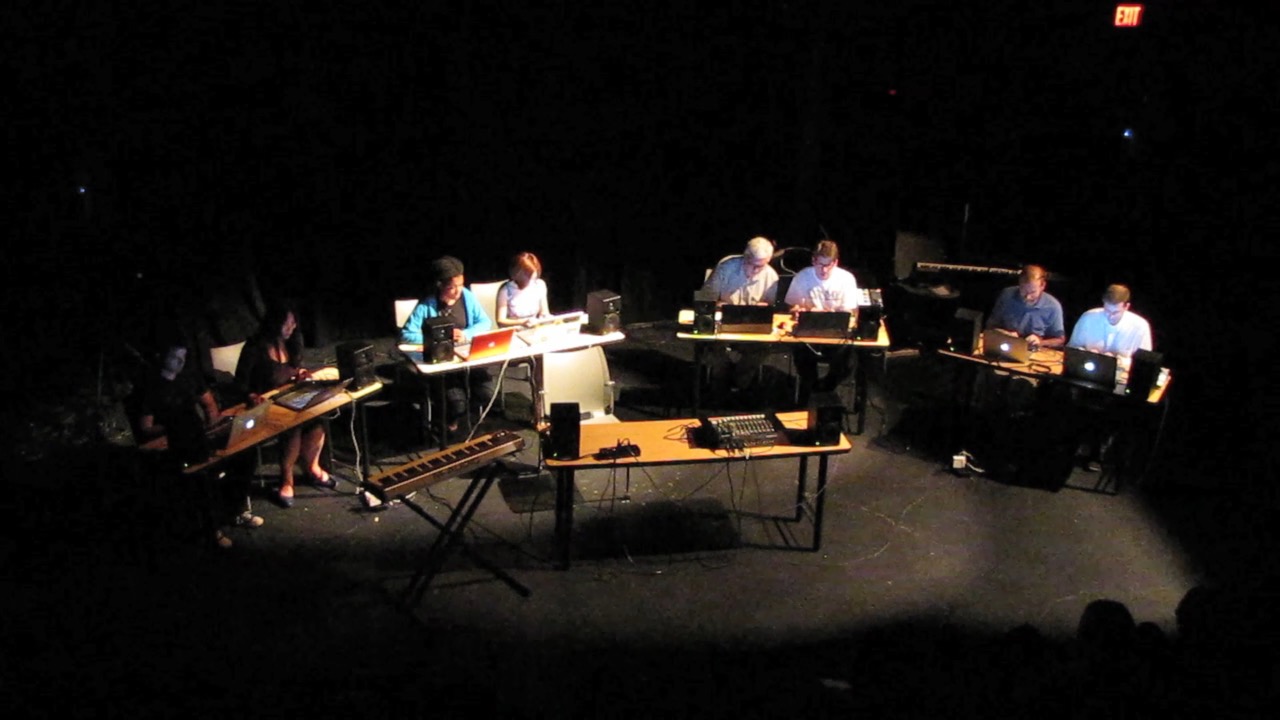
The Charlotte New Music Festival Laptop Ensemble performed Community Trust at
- Charlotte New Music Festival at the Arts Factory at Johnson C. Smith University in Charlotte, NC, June 13, 2015
- Charlotte New Music Festival at the Arts Factory at Johnson C. Smith University in Charlotte, NC, June 4, 2016
Satisfaction Guaranteed (2014), for laptop ensemble or amplified motion-capture tap dancer and laptop ensemble (~10:00)
Score (PDF) | Audio (MP3)
Charlotte New Music Festival Laptop Ensemble
Charles Nichols, director
University of Rome Laptop Ensemble
Charles Nichols, director
Ann Kilkelly, motion-capture tap dance
Linux Laptop Orchestra
Ivica Ico Bukvic, director
Satisfaction Guaranteed was composed for laptop ensembles at the Charlotte New Music Festival and the University of Rome. The structured improvisation, scored with graphic notation, explores various soundscapes of New York City, looping soundfiles recorded while traveling to and around Manhattan. With Wii controller buttons and motion, the performers choose between three soundfiles, select loop start, end, speed, and direction, and manipulate volume, reverb, and delay length and feedback. For a later version of the piece, a tap dancer wearing reflective rings in a 24 camera motion tracking system, moves the output of two computers at a time around the 124.4 channel spatial audio system of the Cube in the Moss Arts Center of Virginia Tech, while adding percussive rhythms to the texture.
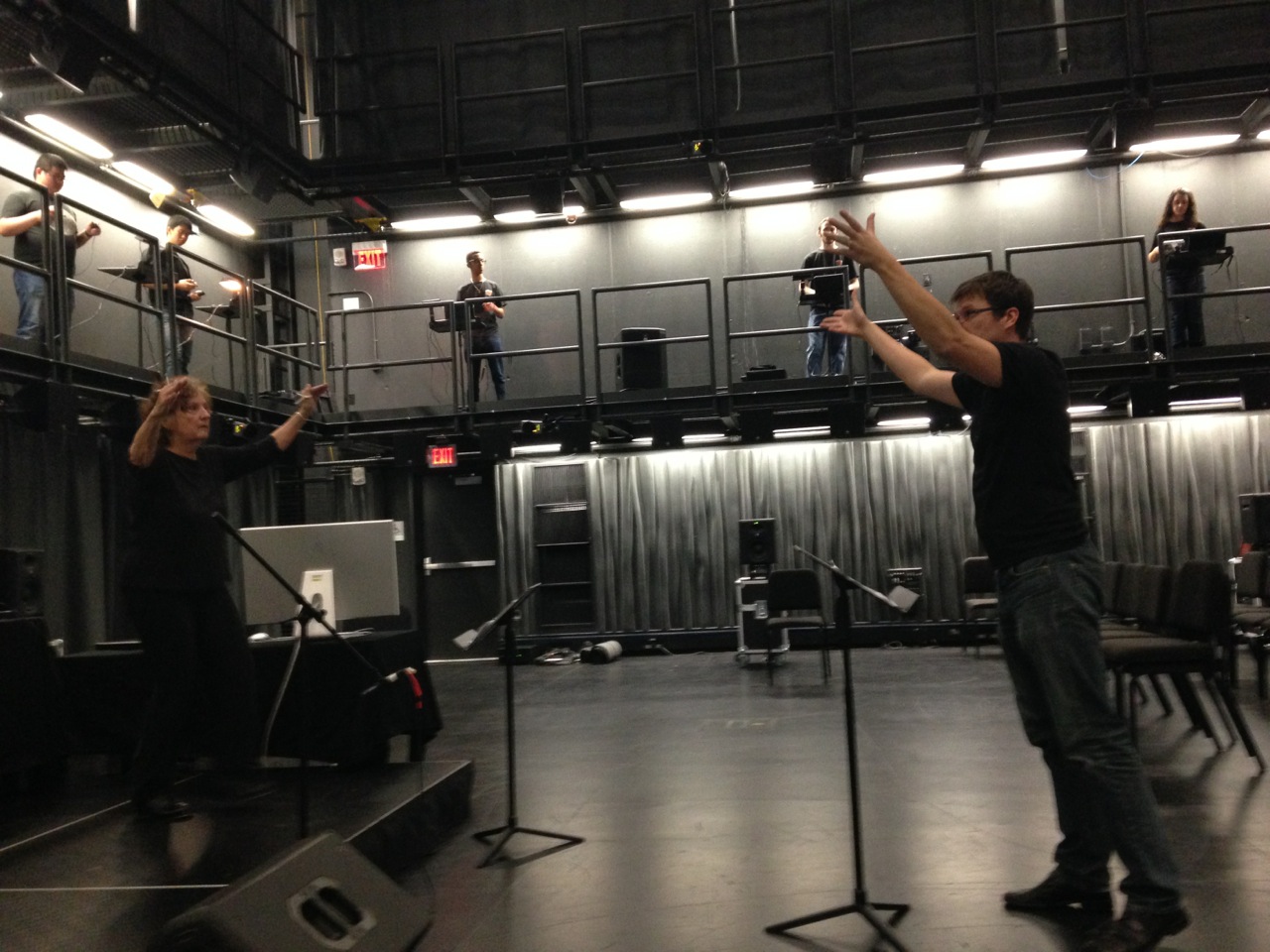
The Charlotte New Music Festival Laptop Ensemble performed Satisfaction Guaranteed at
- Charlotte New Music Festival Laptop Ensemble at Snug Harbor in Charlotte, NC, June 14, 2014
The University of Rome Laptop Ensemble performed Satisfaction Guaranteed at
- Festa Europea Della Musica at the University of Rome "Tor Vergata" in Rome, Italy, June 19, 2014
The Linux Laptop Orchestra performed Satisfaction Guaranteed at
- Electroacoustic Barn Dance at Eyeclopes in Fredericksburg, VA, October 3, 2015
- with amplified motion-capture tap dancer Ann Kilkelly on the DISIS Concert in the Cube of the Moss Arts Center at Virginia Tech in Blacksburg, VA, December 7, 2015
Sound of Rivers: Stone Drum (2013), for electric violin, sonified data, and processed spoken word, accompanying narrated poetry, dance, animation, and processed video (~5:00)
Video (YouTube)
Nicole Bradley Browning, choreography
Amber Bushnell, animation and processed video
Mark Gibbons, poetry
Allison Herther, dance
Stephen Kalm, narration
Charles Nichols, electric violin and computer music
Sound of Rivers: Stone Drum is a multimedia collaboration between a choreographer, animator, poet, dancer, narrator, scientist, and composer, that illuminates research into how insects navigate the ecosystem of floodplains, by the sound of rivers.
The choreography is divided into three sections representing River: under the river, Animal: in the river, and Human: with the river, with Animal comprised of Insect, Fish, and Bird. The dancer interacts with a large cyclorama, a sheet of elastic and reflective fabric, stretched across the width and depth of the stage. At the back of the cyc is a skirt sewn into the fabric, that allows the dancer to insert themselves into the sheet. The dancer is at times under the fabric, pushing and grasping at the cloth, and at other times attached to the sheet, twisting, stretching, billowing, and plucking the expanse.
The projection and animation is divided into three parts. The first, a panel at the back of the stage, that contains striations that undulate in response to a live audio feed from the music, and a colored shadow based on a live video feed of the dancer. Around the panel, also projected on the back of the stage, is intricate animation composed of hand-drawn water diatoms, river plants and trees, insects, and animals, that grow and move in symmetrical patterns, throughout the piece. These river elements were chosen specifically to reflect the health of the river ecosystem, and are interconnected, as they are in the environment. Projected on the cyc, that the dancer interacts with, are animations built from insect and bird wings, fish scales, and cottonwood roots, that grow in density and modulate in color, as they pass over the surface.
The music is divided into three textures. The piece starts with processed spoken text, recordings of the poet reciting his poem, that have been stripped of their harmonic spectrum, stretched in time, and granulated into jittery textures. These soundfiles, based on words, echo the live narrated text, and cascade in parallel along the sides of the audience, through a quadraphonic sound system, encircling the auditorium. The second texture is comprised of filter banks, built from spectral analysis of recordings taken at the field station and on river floats, that filter recordings taken above and below the water, into surging harmonies, that ebb and flow. These harmonies accompany bowed-string physical model synthesized sound, that uses the data of river depth to drive pitch, river velocity for amplitude or loudness, wind speed from the North for bow pressure, and from the East for bow position, creating a sonification of the environmental data. Finally, a violinist performs passages, that combine the scales and rhythmic motives, of the music and instrumentalists mentioned in the poetry, into original melodies, processed with multiple layers of phaser and delay effects, that sweep and echo in the four-channel sound system.
Sound of Rivers: Stone Drum is based on work supported by the Montana Institute on Ecosystems award from NSF EPSCoR Track-1 (INSTEP 3) program under Grant # EPS-1101342 at the University of Montana.

Video artist Amber Bushnell, poet and narrator Mark Gibbons, dancer Allison Herther, and electric violinist and computer musician Charles Nichols performed Sound of Rivers: Stone Drum at
- Dance in Concert in the Montana Theatre at the University of Montana in Missoula, MT, May 8-11, 2013
No Title For Cacophony (2011), structured improvisation for iPhones, Wii controllers, and computer (variable)
Audio (MP3): Excerpt | Video (YouTube)
Members of the Mountain Electroacoustic Laptop Ensemble (MELEe)
with students from Western Washington University
No Title For Cacophony is a structured improvisation, for up to six iPhones running an Mrmr OSC touch interface, or Wii Remotes and Nunchuks, controlling a Max patch, that loops and filters three soundfiles per player, in the categories of pitch, noise, and speech. The Mrmr interface uses buttons to turn on and off or momentarily trigger the soundfiles and turn on and off a comb filter, and faders to change the volume, positive and negative playback speed, filter gain, and filter delay time or pitch. It also uses a range to select start and end samples for the loop, and an accelerometer to spatialize each part independently in quadraphonic sound. The Wii Remotes shake side to side to select start and end samples for the loop, and lock the selection with the B-button trigger. The D-pad controls faders for volume and playback speed, or when the A-button is pushed, the gain and pitch of the filter. The -, home, and + buttons trigger each of the three soundfiles, and the joystick on the Nunchuk spatializes the part. The players follow queues on the screen for overall duration of the piece, duration of the section, category of soundfile to play, and duration of the loop, as well as density, volume, playback speed, filter gain, filter pitch, and panning, in categories of static or active, or transitioning between the two states.

No Title For Cacophony has been performed at
- TechFair at the University of Montana in Missoula, MT, September 8, 2011
- Electroacoustic InterExchange at Western Washington University in Bellingham, WA, March 31, 2012
- Mountain Computer Music Festival in Missoula, MT, September 7, 2012
- International Computer Music Conference in Ljubljana, Slovenia, September 11, 2012
- Society for Electro-Acoustic Music in the United States National Conference in St. Paul, MN, April 18, 2013